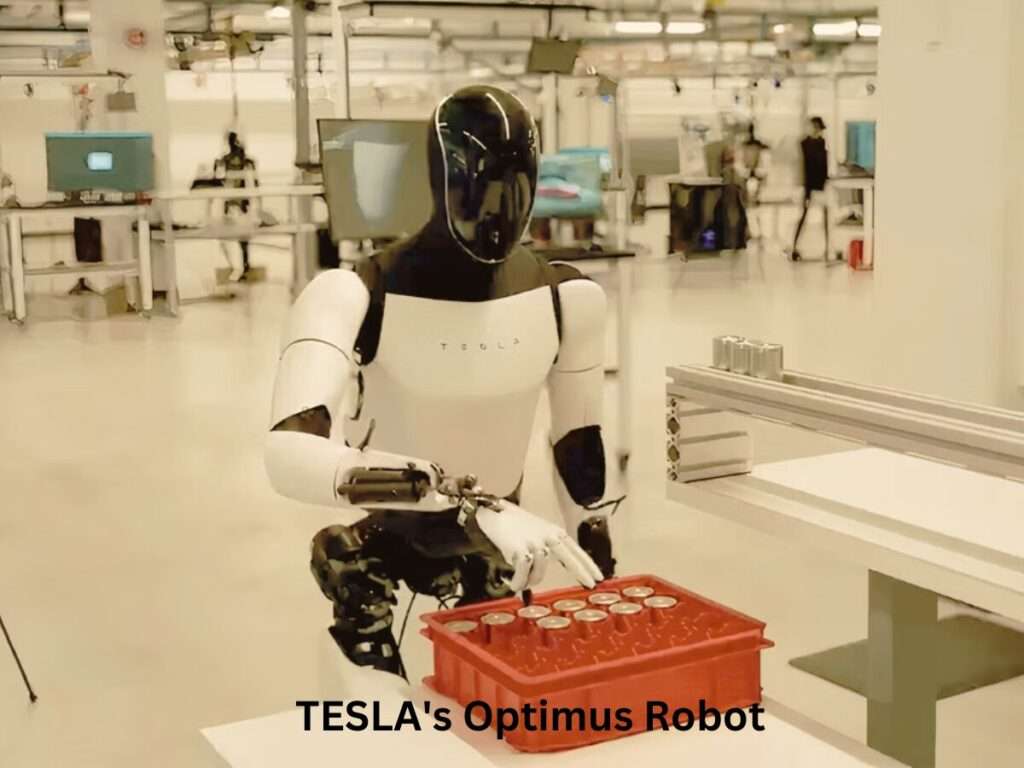
- Tesla has always been a brand synonymous with innovation, and its recent unveiling of the Optimus AI robot marks another landmark in the company’s legacy. Introduced at the “We, Robot” event, Optimus is Tesla’s latest product designed to revolutionise human-robot interaction. It’s not just an idea for the future—Tesla is bringing the future to us now.
- In this blog, we’ll explore the features of Tesla’s Optimus, its potential impact on daily life, and what this launch could mean for the world of robotics and AI.
What is Tesla Optimus AI Robot?
Optimus, also referred to as Tesla Bot, is a humanoid robot designed to mimic human-like movement and behaviours. Standing at about 5 feet 8 inches tall, the robot is created to handle a range of everyday tasks, from simple household chores to more physically demanding duties such as lifting objects. Optimus is expected to operate autonomously, performing tasks that often require human intervention.
What sets Optimus apart from existing robotics is its advanced AI. The robot shares the same neural networks as Tesla’s autonomous vehicles, meaning it can adapt, learn, and navigate through environments much like the autopilot feature in Tesla cars. Optimus is built with a focus on safety and reliability, ensuring it can perform its tasks without posing a risk to humans.
Everyday Tasks with an AI Twist
One of the biggest selling points of Optimus is its ability to take over mundane tasks. Imagine a world where robots walk your pets, carry packages, and even help with grocery shopping. This is exactly the kind of future Tesla is aiming to create. According to Elon Musk, the Optimus robot will have capabilities beyond simple automation—it will be able to perform complex, routine tasks that we often take for granted.
For instance, Optimus could be used in manufacturing environments where repetitive and heavy lifting is required, or it could assist older individuals with tasks like carrying groceries. In homes, it could clean, organise, or even prepare meals. This shift in robotics technology could drastically reduce the time and energy humans spend on daily chores.
A Game-Changer for Industries
Optimus is not just a gadget for personal use; its applications extend into various industries. One of the most significant impacts could be on labour-intensive sectors such as manufacturing and logistics. By taking over repetitive, manual tasks, Optimus could free up human workers for more creative and strategic roles. The robot’s human-like design allows it to function in environments built for humans, making it easy to integrate into existing workspaces.
Moreover, Tesla envisions Optimus playing a crucial role in economic productivity. Elon Musk stated that widespread adoption of the robot could result in significant economic gains, even going so far as to suggest that Optimus might contribute to eliminating global poverty by increasing economic output.
Pricing and Availability of Tesla Optimus AI Robot
One of the most intriguing aspects of the Optimus robot is its affordability. While robots of this sophistication usually come with sky-high prices, Musk has hinted that Optimus could be available for as little as $20,000 to $30,000. This pricing makes it accessible not only for large corporations but also for small businesses and households.
Tesla’s Optimus is still in its development phase, but the prototype presented shows immense promise. Musk expects that with further iterations, the robot will become more functional, versatile, and available to the broader public within the next few years.
The Future of Human-Robot Interaction
The launch of Optimus signals a shift in how we view robots in daily life. No longer limited to industrial settings or niche applications, Tesla’s AI robot aims to become a household assistant, seamlessly integrating into personal spaces. Musk has suggested that future versions of Optimus could go beyond mere functionality, eventually evolving into companions that understand human emotions and needs.
However, this futuristic vision does come with its challenges. As AI and robotics become more advanced, questions around ethics, privacy, and job displacement arise. While Optimus may be designed to improve productivity, it is essential to ensure that its widespread use does not negatively impact job markets or human interaction.
Challenges and Ethical Considerations
Tesla’s introduction of the Optimus robot also brings forth critical ethical discussions. While automation has proven to increase efficiency and productivity, it has also raised concerns about potential job losses. The Optimus robot, capable of replacing certain manual labour roles, could result in significant job displacement in industries that rely heavily on human workers.
Additionally, there are privacy concerns surrounding the data collected by AI systems. Since Optimus will likely interact closely with humans in their homes and workplaces, maintaining data security and ensuring that personal information is safeguarded will be crucial.
Tesla has a responsibility to address these issues as it continues to develop the Optimus robot. Incorporating strong privacy measures, fair labour policies, and responsible AI use will be essential in ensuring the positive impact of this technology on society.
Conclusion
Tesla’s unveiling of the Optimus AI robot is a bold and exciting step towards the future of automation. With its advanced capabilities, human-centric design, and potential to perform everyday tasks, Optimus could redefine how we interact with machines. The robot’s potential to impact industries, improve productivity, and reduce human effort in mundane activities is immense.
However, as with any technological breakthrough, there are challenges to consider. Ethical concerns around job displacement, privacy, and the responsible use of AI must be addressed as we move towards an automated future. As Tesla continues to refine Optimus, we can only imagine the possibilities that this technology will bring. What’s certain is that the future of robotics just got a lot more exciting.

